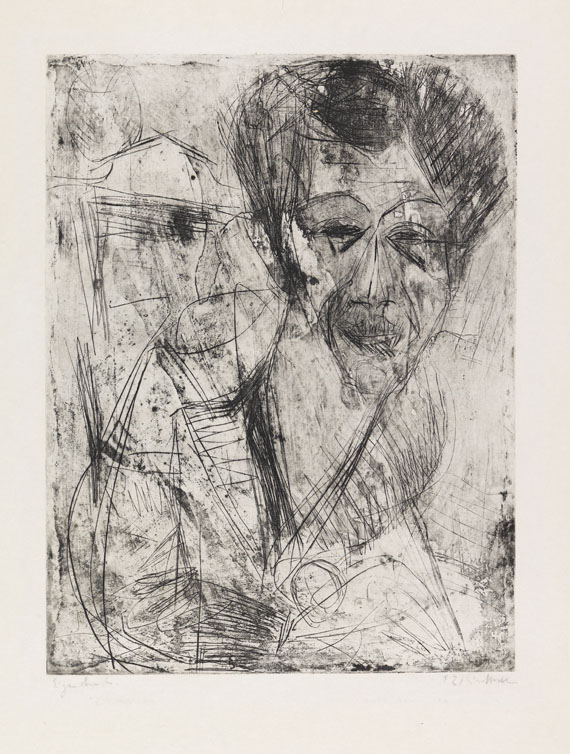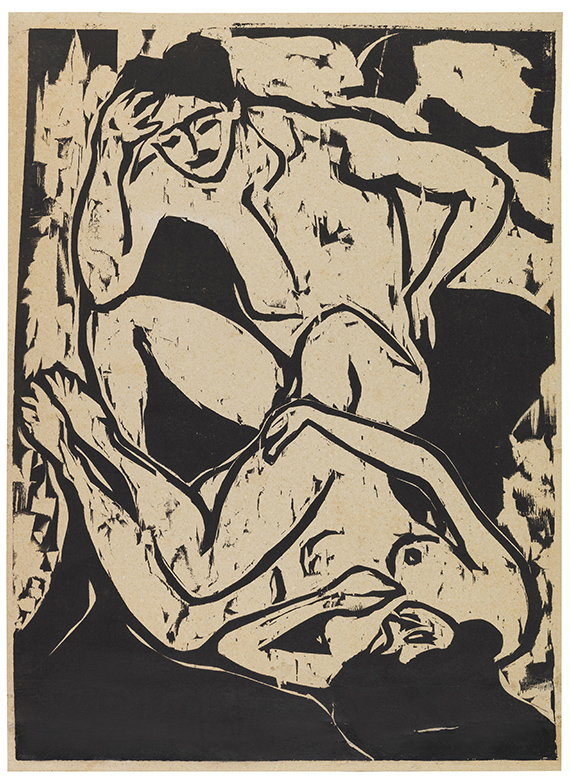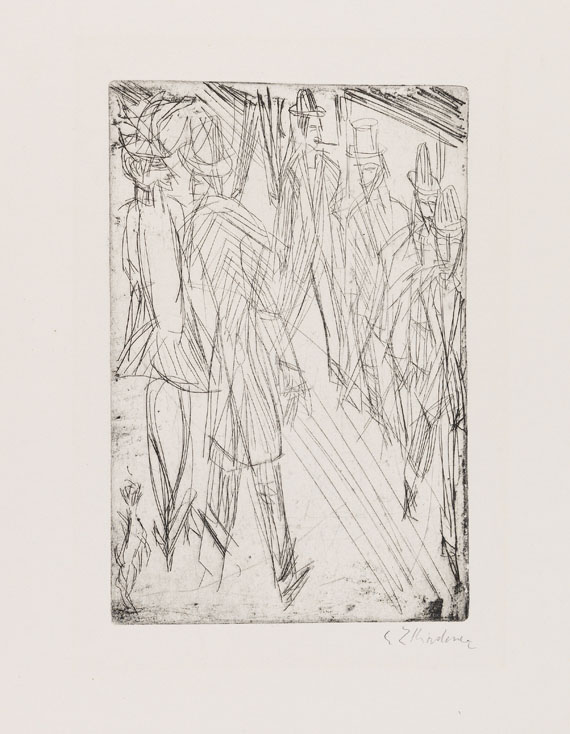219
Ernst Ludwig Kirchner
Damenkapelle (Im Konzertsaal), 1908.
Etching, green print
Estimate:
€ 35,000 - 45,000
$ 38,500 - 49,500
Damenkapelle (Im Konzertsaal). 1908.
Etching, green print.
Signed, dated and inscribed “Eigendruck” (artist's print), as well as titled “Im Konzertsaal” by hand in the lower margin. One of presumably 8 known copies. On firm wove paper. 28 x 30.8 cm (11 x 12.1 in). Sheet: 32 x 32,6 cm (12,5 x 12,8 in).
[AR]
The "Brücke": Expressionism on Paper – The Passion of a German Collector
Further works from the collection will be offered in our Evening Sale on Friday, December 6, 2024, and in the simultaneous Online Sale (Auction ends on December 15, 2024).
• Rare, magnificent original print in dark green from the best “Brücke” period.
• From the circle of dance motifs, cabaret, and circus, which is central to Kirchner's oeuvre: a voyeuristic snapshot of Dresden nightlife.
• In private family ownership for almost 60 years.
• Copies of this print are scarce on the international auction market.
• Further copies can be found in the Museum of Modern Art in New York, the Hammer Museum in Los Angeles, and the Buchheim Museum in Bernried.
We are grateful to Prof. Dr. Günther Gercken for his kind support in cataloging this lot.
PROVENANCE: Private collection, Hesse (since 1965: Kornfeld und Klipstein).
Family-owned ever since.
LITERATURE: Günther Gercken, Ernst Ludwig Kirchner. Kritisches Werkverzeichnis der Druckgraphik, vol. 1 (1904-1908), Bern 2013, catalogue raisonné no. 208 3 (of 3).
- -
Kornfeld und Klipstein, Bern, 116th auction, Modern Art, June 18, 1965, lot 469 (illustrated on plate 118).
Called up: December 7, 2024 - ca. 14.45 h +/- 20 min.
Etching, green print.
Signed, dated and inscribed “Eigendruck” (artist's print), as well as titled “Im Konzertsaal” by hand in the lower margin. One of presumably 8 known copies. On firm wove paper. 28 x 30.8 cm (11 x 12.1 in). Sheet: 32 x 32,6 cm (12,5 x 12,8 in).
[AR]
The "Brücke": Expressionism on Paper – The Passion of a German Collector
Further works from the collection will be offered in our Evening Sale on Friday, December 6, 2024, and in the simultaneous Online Sale (Auction ends on December 15, 2024).
• Rare, magnificent original print in dark green from the best “Brücke” period.
• From the circle of dance motifs, cabaret, and circus, which is central to Kirchner's oeuvre: a voyeuristic snapshot of Dresden nightlife.
• In private family ownership for almost 60 years.
• Copies of this print are scarce on the international auction market.
• Further copies can be found in the Museum of Modern Art in New York, the Hammer Museum in Los Angeles, and the Buchheim Museum in Bernried.
We are grateful to Prof. Dr. Günther Gercken for his kind support in cataloging this lot.
PROVENANCE: Private collection, Hesse (since 1965: Kornfeld und Klipstein).
Family-owned ever since.
LITERATURE: Günther Gercken, Ernst Ludwig Kirchner. Kritisches Werkverzeichnis der Druckgraphik, vol. 1 (1904-1908), Bern 2013, catalogue raisonné no. 208 3 (of 3).
- -
Kornfeld und Klipstein, Bern, 116th auction, Modern Art, June 18, 1965, lot 469 (illustrated on plate 118).
Called up: December 7, 2024 - ca. 14.45 h +/- 20 min.
“The images captured life directly and richly,” Ernst Ludwig Kirchner summed up retrospectively. The abundance of dance halls, cabarets, and circus arenas becomes the central theme of the expressive art of the ‘Brücke’. In this large-format etching, Kirchner shows us what captured the spirit of the age in European urban centers from 1900 onward, sparking a real hype on the dance floors and among the spectators. A uniformed ladies' band with pinned-up hair whips the (unseen) dancing couples into a wild performance, evoking memories of the film Cabaret, starring Liza Minelli and the legendary female combo. The arches in the background resemble the backdrop of a cabaret, of which there were many in Dresden, such as the establishments near Altmarkt, the 'Central Theater,' and the 'Victoria Salon.' A scene that is both theatrical and erotic arises from these darkened rooms, while the sketchy nature of a hustling demimonde is also addressed.
With the bald man in the foreground, Kirchner anticipated the depiction of the social winners by George Grosz from the 1920s. It is a tribute to the golden age of entertainers who, with their eccentric music and dance, had sent audiences into ecstasy before the First World War. Kirchner, who had a penchant for vaudeville and dance, brought modernity to the world of the stage in his drawings and paintings, staging the social and cultural upheavals of his time. The influence of French Impressionism, as exemplified by Degas and Toulouse-Lautrec, is just as recognizable as the novel approach taken by Degas and Matisse at the beginning of the century, which treated dance as an expression of changing ways of life. Kirchner felt at home in the ballrooms and variety theaters, modeled on their French counterparts, known as cabarets in Dresden, Germany. [MvL]
The "Brücke": Expressionism on Paper – The Passion of a German Collector
The Hessian collector recollects his first encounter with Expressionist art to this day: it was shortly after the end of World War II that he was struck by Karl Schmidt-Rottluff paintings on a visit to the Frankfurter Kunstkabinett. The gallery was one of the first in Germany to offer art lovers an opportunity to see works by the artists of the "Brücke" group again, as they had been ostracized as "degenerate" by the Nazis. One of the main reasons behind Hanna Bekker von Rath's decision to open the place on Börsenplatz in Frankfurt in 1947 was to provide a forum for these artists after the dark years of Nazi rule and to reintroduce them to the public. “These works blew me away” is how the collector recalls his initial reaction to the exhibits. He liked Schmidt-Rottluff's rugged, woodcut-like style and subsequently also developed a liking for the other members of the “Brücke”, whose style was so different from what had previously been considered “beautiful”. Together with his wife – who was particularly interested in the works of Otto Mueller and Emil Nolde – he visited many more exhibitions at the Frankfurt Kunstkabinett and other galleries.
Nevertheless, it was about more than just admiring them. In 1962, the couple bought their first Expressionist work at auction in Stuttgart – from Roman Norbert Ketterer, the uncle of the current owner of Ketterer Kunst: Ernst Ludwig Kirchner's woodcut "Drei Akte im Wald" from 1933 marked the beginning of the couple's extensive collection of "Brücke" prints.
He never had a specific system, says the collector. However, he avoided acquiring pieces that “many others had as well”. He was particularly interested in works produced in small numbers, pieces with a unique feature such as an additional coat of paint, or works that the artist used as trial proofs. But first and foremost, says the collector, “I made my purchases based on my taste”.
Further works from the collection will be offered in our Evening Sale on Friday, December 6, 2024, and in the simultaneous Online Sale (Auction ends on December 15, 2024)
With the bald man in the foreground, Kirchner anticipated the depiction of the social winners by George Grosz from the 1920s. It is a tribute to the golden age of entertainers who, with their eccentric music and dance, had sent audiences into ecstasy before the First World War. Kirchner, who had a penchant for vaudeville and dance, brought modernity to the world of the stage in his drawings and paintings, staging the social and cultural upheavals of his time. The influence of French Impressionism, as exemplified by Degas and Toulouse-Lautrec, is just as recognizable as the novel approach taken by Degas and Matisse at the beginning of the century, which treated dance as an expression of changing ways of life. Kirchner felt at home in the ballrooms and variety theaters, modeled on their French counterparts, known as cabarets in Dresden, Germany. [MvL]
The "Brücke": Expressionism on Paper – The Passion of a German Collector
The Hessian collector recollects his first encounter with Expressionist art to this day: it was shortly after the end of World War II that he was struck by Karl Schmidt-Rottluff paintings on a visit to the Frankfurter Kunstkabinett. The gallery was one of the first in Germany to offer art lovers an opportunity to see works by the artists of the "Brücke" group again, as they had been ostracized as "degenerate" by the Nazis. One of the main reasons behind Hanna Bekker von Rath's decision to open the place on Börsenplatz in Frankfurt in 1947 was to provide a forum for these artists after the dark years of Nazi rule and to reintroduce them to the public. “These works blew me away” is how the collector recalls his initial reaction to the exhibits. He liked Schmidt-Rottluff's rugged, woodcut-like style and subsequently also developed a liking for the other members of the “Brücke”, whose style was so different from what had previously been considered “beautiful”. Together with his wife – who was particularly interested in the works of Otto Mueller and Emil Nolde – he visited many more exhibitions at the Frankfurt Kunstkabinett and other galleries.
Nevertheless, it was about more than just admiring them. In 1962, the couple bought their first Expressionist work at auction in Stuttgart – from Roman Norbert Ketterer, the uncle of the current owner of Ketterer Kunst: Ernst Ludwig Kirchner's woodcut "Drei Akte im Wald" from 1933 marked the beginning of the couple's extensive collection of "Brücke" prints.
He never had a specific system, says the collector. However, he avoided acquiring pieces that “many others had as well”. He was particularly interested in works produced in small numbers, pieces with a unique feature such as an additional coat of paint, or works that the artist used as trial proofs. But first and foremost, says the collector, “I made my purchases based on my taste”.
Further works from the collection will be offered in our Evening Sale on Friday, December 6, 2024, and in the simultaneous Online Sale (Auction ends on December 15, 2024)
219
Ernst Ludwig Kirchner
Damenkapelle (Im Konzertsaal), 1908.
Etching, green print
Estimate:
€ 35,000 - 45,000
$ 38,500 - 49,500
Buyer's premium and taxation for Ernst Ludwig Kirchner "Damenkapelle (Im Konzertsaal)"
This lot can be purchased subject to differential or regular taxation.
Differential taxation:
Hammer price up to 800,000 €: herefrom 32 % premium.
The share of the hammer price exceeding 800,000 € is subject to a premium of 27 % and is added to the premium of the share of the hammer price up to 800,000 €.
The share of the hammer price exceeding 4,000,000 € is subject to a premium of 22 % and is added to the premium of the share of the hammer price up to 4,000,000 €.
The buyer's premium contains VAT, however, it is not shown.
Regular taxation:
Hammer price up to 800,000 €: herefrom 27 % premium.
The share of the hammer price exceeding 800,000 € is subject to a premium of 21% and is added to the premium of the share of the hammer price up to 800,000 €.
The share of the hammer price exceeding 4,000,000 € is subject to a premium of 15% and is added to the premium of the share of the hammer price up to 4,000,000 €.
The statutory VAT of currently 19 % is levied to the sum of hammer price and premium. As an exception, the reduced VAT of 7 % is added for printed books.
We kindly ask you to notify us before invoicing if you wish to be subject to regular taxation.
Differential taxation:
Hammer price up to 800,000 €: herefrom 32 % premium.
The share of the hammer price exceeding 800,000 € is subject to a premium of 27 % and is added to the premium of the share of the hammer price up to 800,000 €.
The share of the hammer price exceeding 4,000,000 € is subject to a premium of 22 % and is added to the premium of the share of the hammer price up to 4,000,000 €.
The buyer's premium contains VAT, however, it is not shown.
Regular taxation:
Hammer price up to 800,000 €: herefrom 27 % premium.
The share of the hammer price exceeding 800,000 € is subject to a premium of 21% and is added to the premium of the share of the hammer price up to 800,000 €.
The share of the hammer price exceeding 4,000,000 € is subject to a premium of 15% and is added to the premium of the share of the hammer price up to 4,000,000 €.
The statutory VAT of currently 19 % is levied to the sum of hammer price and premium. As an exception, the reduced VAT of 7 % is added for printed books.
We kindly ask you to notify us before invoicing if you wish to be subject to regular taxation.




 Lot 219
Lot 219 




